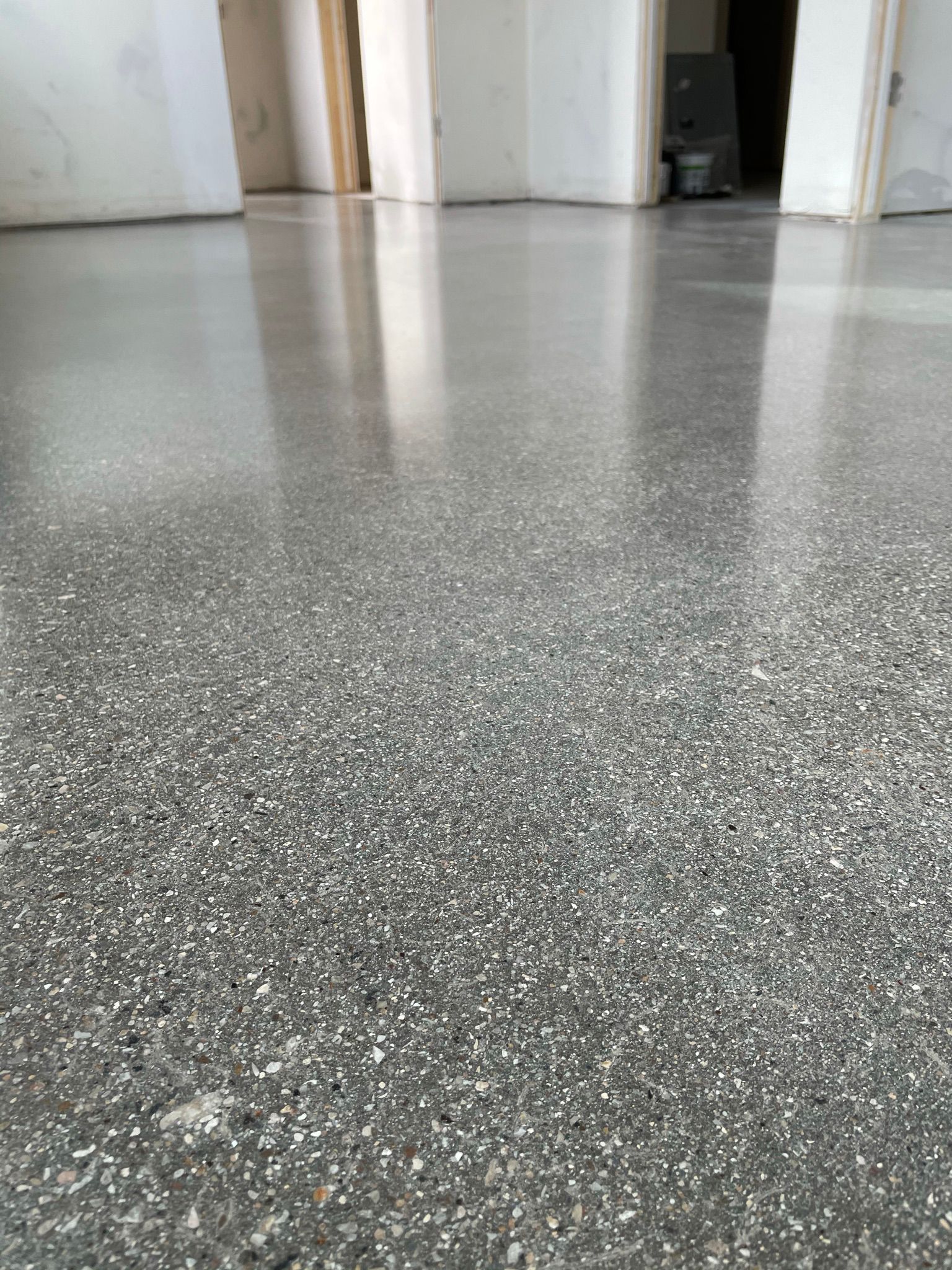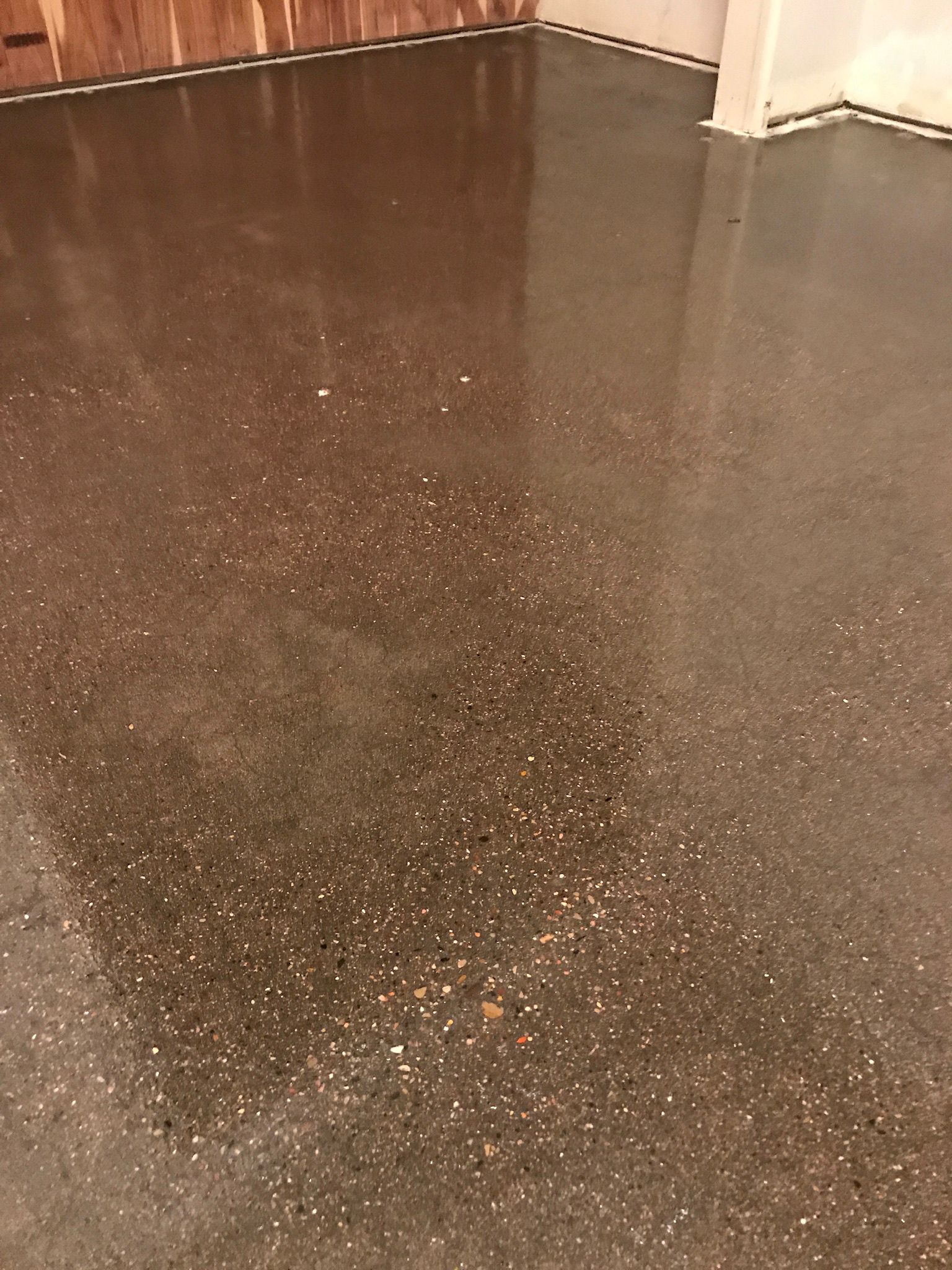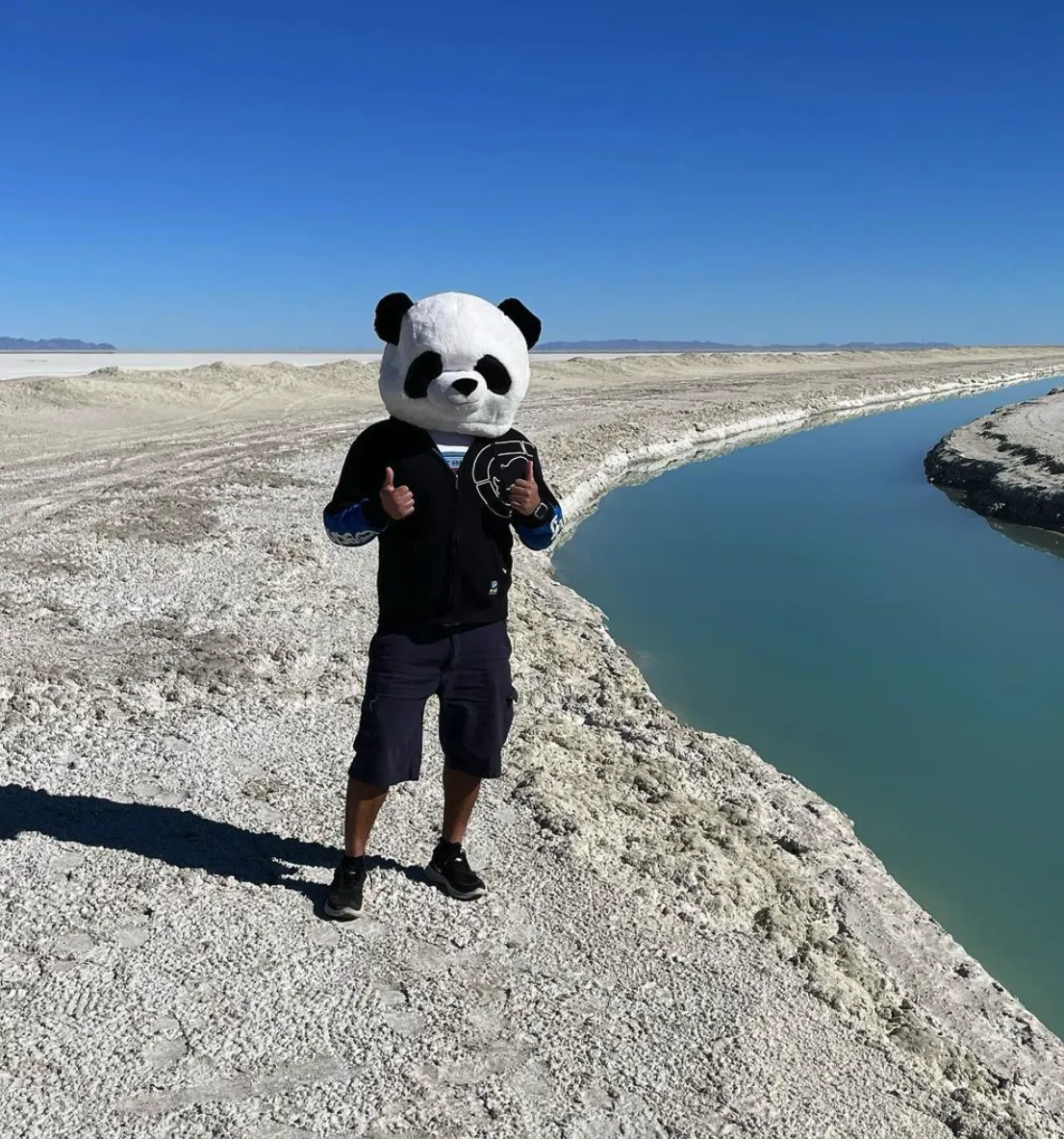Polished Concrete Repair
Restore the Strength and Shine of Your Polished Concrete Floors
Polished concrete is one of the toughest, lowest-maintenance flooring systems around—but even the toughest surfaces break down over time. Whether it’s from slab movement, heavy traffic, moisture intrusion, or just plain neglect, even a well-polished floor can lose its luster, crack, or become uneven.
At Ayala’s Concrete Designs, we specialize in bringing tired concrete floors back to life. This isn’t about throwing down a quick patch or applying a coating to cover it up. We diagnose the problem, repair the damage at the slab level, and restore the finish with proper densifying, honing, and polishing. The result? A floor that not only looks great again but performs like it should.
If you’re dealing with cracks, dull areas, or a floor that just isn’t what it used to be—we’re the crew to call. Let’s fix it right the first time.
Is Your Polished Concrete Floor Telling You It’s Time for Repairs?
Concrete doesn’t lie. When something’s wrong, it shows—and if you know what to look for, you can catch the problem before it gets worse (and more expensive to fix). Here are some of the most common signs that your polished concrete floor is due for professional repair:
Loss of Gloss or Clarity
A polished concrete floor should reflect light cleanly. If the shine is gone or it’s starting to look hazy and dull, the surface may be worn down, etched, or under-hardened.Visible Scratches or Surface Damage
Dragged equipment, forklifts, or even sand and grit underfoot can cause scuffing, gouges, or wear patterns—especially in high-traffic lanes or commercial spaces.Cracks or Joint Failures
Cracks that weren’t filled properly or joints that are starting to break down will eventually grow and telegraph through the surface. These aren’t just cosmetic—they’re signs of structural movement.Uneven Wear Patterns
If some areas are shiny and others look dull, your floor has inconsistent surface density. That usually means your densifier has failed or the slab wasn’t properly polished to begin with.Stains or Discoloration
From rust spots and oil leaks to chemical etching and water damage, stains can sink deep into the concrete and cause long-term issues if they’re not treated correctly.Dusting or Chalking
A properly polished concrete floor should be dense and dust-free. If you’re seeing fine powder or “chalky” residue, the surface is breaking down—usually due to moisture or poor densification.

If any of these are happening in your home, shop, or commercial space, don’t ignore it. We’ve seen polished concrete floors go from recoverable to completely unsalvageable when left untreated, at a minimum the repairs get more expensive the longer you wait. Let’s stop the damage now and get your floor back to doing what it’s meant to: looking sharp and lasting decades.
Get a Free Floor Assessment
Don’t wait for cracks to spread or the whole floor to lose its finish. Let us take a look and give you a straight answer—no pressure, no fluff. Just expert insight from St. George’s polished concrete repair specialists.

Our repair work can be done on residential, commercial, and even industrial floors—always tailored to the age and condition of your concrete. We don’t just fix floors. We bring them back to life with the same attention to detail we bring to every full polish system.
Get Your Free Polished Concrete Repair Quote Today!
Don’t wait for cracks to grow or the finish to wear down completely. We’ll inspect the damage, explain what’s going on, and tell you exactly what it’ll take to fix it—no guesswork, no sales pitch. Just honest advice from St. George’s polished concrete repair pros.
What Polished Concrete Repair Really Means
Polished concrete repair isn’t just about fixing what’s visible on the surface—it’s about restoring the entire system so your floor looks and performs like it should. At Ayala’s Concrete Designs, we tackle polished concrete repair from the ground up, addressing both the underlying issues and the finish itself.
Here’s what that includes:
Crack Repair and Joint Stabilization
We don’t just fill cracks—we diagnose why they’re happening, then use proper routing, repair materials, and joint systems to prevent further movement or telegraphing.Surface Re-Honing
If your floor has lost its shine or has been scratched and etched, we bring back the clarity by re-honing the surface through progressive resin grits. It’s a reset, not a patch.Polishing & Gloss Restoration
We re-polish using the same professional process we’d use on a new floor. No shortcuts—just clean, reflective results that match (or beat) the original finish.Stain and Etching Removal
We treat and grind out deep stains, rust marks, and etching from chemicals or spills—then polish and seal to prevent it from coming back.Densifier Reapplication
Over time, your surface may lose its hardness and begin dusting. We re-apply lithium or sodium silicate densifiers as needed to restore surface integrity.Fixing Bad Coatings on Polished Concrete
Got a floor someone tried to “fix” with a cheap coating or paint? We remove the mess, deep-clean the slab, and polish it properly—no more peeling, bubbling, or trap moisture issues.
Why Polished Concrete?
Every concrete floor has a history—and we take the time to understand it before we touch a grinder. Our repair process is built around real diagnostics, professional tooling, and the kind of craftsmanship that comes from years of doing this the right way.
Here’s how we restore your floor:
1. Inspection & Diagnosis
We start with a detailed on-site assessment. We check the condition of the slab, look for movement, moisture issues, patchwork failures, and wear patterns. We figure out what’s really going on before making any recommendations.
4. Densification & Hardening
We apply densifier to harden the surface and protect it against future wear and tear. This step is critical, it not only rebuilds the floor’s structural strength but also enhances its resistance to dusting, abrasion, and wear.
2. Crack & Joint Repair
Whether you’ve got shrinkage cracks, joint separation, or slab movement, we repair and stabilize the concrete with the right materials and prep. That includes routing, cleaning, and properly bonding the repair so it doesn’t fail.
5. Polishing & Finish Restoration
Using high-grit resins, we bring back the shine—whether you want a low-sheen matte or a full reflective gloss. We tailor the finish based on traffic levels, maintenance needs, and your aesthetic goals.
3. Surface Prep & Re-Honing
We re-hone the floor using professional metal and resin-bond tooling, just like we would on a full polish job. No wax, no coatings—just real mechanical refinement to remove damage and restore clarity.
6. Stain & Dye Touch-Ups
If your floor was colored or had decorative treatments, we can reapply or spot-correct those as needed. We can also transition into polishable overlays if the slab isn’t worth saving (we’ll be straight with you about that too).
Why Not Just Patch It?
We’ve seen it too many times—someone slaps down a patching compound or rolls on a coating to hide the damage. And for a minute? Sure, it looks better. But polished concrete doesn’t work that way. You can’t just fill in the bad spots and expect the floor to last.
Here's why quick fixes fail:
Polished Concrete is a System, Not a Surface
That shine you see isn’t just from a buffer—it’s the result of mechanical grinding, densifying, and polishing the slab itself. If you patch one area and skip the rest, the repair sticks out like a sore thumb—and won’t wear the same way as the surrounding concrete.Coatings Trap Moisture and Peel
We see it all the time: someone paints over polished concrete with epoxy or “concrete sealer” to cover damage. Problem is, those coatings don’t bond well to polished surfaces—and they often trap moisture underneath. The result? Peeling, bubbling, and even more costly repairs down the road.
Bad Repairs Make Real Fixes More Expensive
Once you’ve got patchwork material bonded to your floor, we have to grind it all out just to get started. It adds time, cost, and risk—and in some cases, the slab is too far gone to polish again.
You’ll Be Fixing It Again in a Year
If the root issues aren’t addressed—like slab movement, improper densification, or bad polishing technique—the floor will keep breaking down no matter how many times you patch it.
If it sounds like we’re being harsh, it’s because we’ve spent years cleaning up after bad repair jobs. We’d rather do it right the first time—and give you a floor that lasts another 10–20 years instead of another 6 months.
Why Choose Ayala’s for Your Polished Concrete Repairs
Let’s be honest—most contractors don’t want to touch a polished concrete repair job. It’s tricky, it takes real experience, and there’s no hiding sloppy work. But that’s exactly why people call Ayala’s.
We’re not some pop-up crew with a rental grinder and a van full of promises. We’re polished concrete specialists who know how to repair floors the right way—because we install full polish systems every day. That matters.
Here’s what sets us apart:
We Know Southern Utah Concrete
From sun-damaged garage floors to slab movement in commercial buildings, we’ve seen what Southern Utah’s climate and soils do to concrete. Our repairs are built to hold up here—not just look good for a photo.Full-Service Restoration Experts
We don’t just polish. We grind, densify, repair, color, and maintain concrete floors. That means we approach your repair with a full system mindset—not as a band-aid fix.Transparent Quotes, No Runaround
We’ll tell you exactly what the floor needs, what’s optional, and what’s not worth spending money on. If your slab can’t be polished again, we’ll say so. If it just needs a light rehone and reseal, we won’t upsell a full resurface.Trusted by Homeowners and Builders Alike
From residential garages to high-end custom homes and commercial spaces, we’ve earned the trust of clients who care about quality—and come back to us when it counts.Locally Owned, Personally Invested
We’re a family-run company that built our name on doing things right. You won’t be dealing with a franchise or subcontractor. You’ll be working directly with a team that stands behind every repair.

Bottom line: if your polished concrete floor is damaged, worn, or just not living up to the promise—it’s time to bring in the pros who know how to bring it back. That’s Ayala’s.
Let’s Get Your Concrete Floor Fixed Right
Polished concrete repair isn’t something you want to gamble on. Whether your floor needs a light refresh or a full restoration, Ayala’s Concrete Designs has the knowledge, equipment, and integrity to do it right—the first time.
Get in touch now for a free repair assessment.
No pressure. No sales games. Just expert advice and honest work from a local team that stands behind every slab.
Polished Concrete Repair
Frequently Asked Questions
How do I know if my polished concrete floor needs to be repaired?
The most common signs your polished concrete floor needs repair include dullness, loss of gloss, visible scratches, cracking, staining, and uneven wear patterns. If your floor used to reflect light clearly but now looks hazy or flat, that’s a sign the surface has worn down. Surface-level cracks can indicate movement beneath the slab or joint failure. Stains from rust, oil, or chemicals are also red flags, especially if they can’t be removed with standard cleaning. Another warning sign is dusting—a fine white powder that means the surface is breaking down. If you notice any of these issues, it’s worth getting a professional assessment before the damage spreads or becomes more expensive to fix.
Can cracks in polished concrete be repaired without redoing the whole floor?
Yes, most cracks in polished concrete can be repaired without redoing the entire floor. The key is understanding the type of crack and what caused it. At Ayala’s, we start by inspecting whether the crack is structural, cosmetic, or from slab movement. For many surface cracks or failed joints, we can route and fill them using high-performance materials that are compatible with polished surfaces. We then re-hone and polish the area to blend the repair into the surrounding floor. When done right, the repair becomes nearly invisible. If the crack is severe or caused by major slab failure, we may recommend a polishable overlay instead of a patch to ensure long-term durability.
Why is my polished concrete floor losing its shine?
Polished concrete can lose its shine for a few different reasons, and it usually comes down to wear and maintenance. Over time, foot traffic, equipment use, and even grit tracked in from outside can wear down the micro-polished surface. If the floor wasn’t properly densified during installation, the surface may break down faster and start to dust or dull. Another factor is improper maintenance—using harsh chemicals or dirty mops can leave residues that cloud the finish. Luckily, floors that are dull but not damaged can often be revived with a light re-hone and polish. We assess the surface, clean deeply, reapply densifier if needed, and mechanically polish the floor to restore the original gloss.
Can I just coat over a damaged polished concrete floor?
While it might seem easier to apply a coating over a damaged polished concrete floor, it's usually a bad idea. Most coatings don’t bond well to a polished surface, especially if densifier or sealers are still present. The result? Peeling, bubbling, or delamination in a matter of months. Worse, coatings can trap moisture in the slab, leading to further damage underneath. If the goal is to restore performance and appearance, mechanical repair is the better long-term option. We recommend inspecting the damage, fixing any underlying slab issues, and then rehoning and repolishing the floor properly. If a coating is truly desired, the surface must be mechanically profiled first to ensure adhesion.
Can you fix a bad polished concrete job from another contractor?
Yes, we frequently repair and restore polished concrete floors that were poorly done by other contractors. Common problems include uneven polish levels, swirl marks, hazing, visible scratches, poor densification, or patchy finishes. In many cases, these are caused by rushing the job, skipping grits, or using cheap tooling. We start by evaluating what went wrong, then correct it with a full-spectrum re-hone and polish if the slab allows. Sometimes, we’ll need to grind deeper or repair the surface before starting over. Our goal is to not only fix the flaws but make the floor stronger and more consistent than it ever was before.
Will the repaired area match the rest of my floor?
When done correctly, yes—repaired areas can blend seamlessly into the existing polished concrete. The key is using matching repair materials, proper grinding techniques, and polishing the area with the same grit progression as the original floor. At Ayala’s, we take time to feather in transitions so there are no hard edges or gloss mismatches. In some cases, we may recommend polishing the entire room or zone to achieve full uniformity, especially if the surrounding area is also worn or dull. Our goal is to restore performance and appearance so that your floor looks like one continuous surface.
Is it worth repairing a polished concrete floor, or should I replace it?
In most cases, it’s far more cost-effective to repair a polished concrete floor than to replace it. Removal and replacement of concrete is invasive, expensive, and time-consuming. If the slab is still structurally sound, polishing it back into shape is almost always the better investment. Even if there are multiple cracks, stains, or dull areas, they can usually be repaired through grinding, filling, densifying, and polishing. In cases where the original slab is too damaged to polish again, we may recommend installing a polishable overlay—a new concrete topping that can be treated like a fresh slab. We’ll always give you the honest answer based on what makes the most long-term sense.
How can I prevent my polished concrete floor from needing repairs again?
Regular maintenance is the key to protecting your polished concrete and extending its lifespan. That means daily dust mopping, neutral pH cleaners, and avoiding harsh chemicals or abrasive pads. For high-traffic areas, especially in commercial or industrial spaces, periodic re-burnishing or re-polishing can keep the finish looking sharp and prevent wear from getting out of control. Keeping control joints clean and sealed also reduces the chance of cracks or joint failures. At Ayala’s, we offer maintenance plans and check-ins so you can stay ahead of problems and protect your investment. A little upkeep goes a long way in keeping polished concrete looking great for decades.



